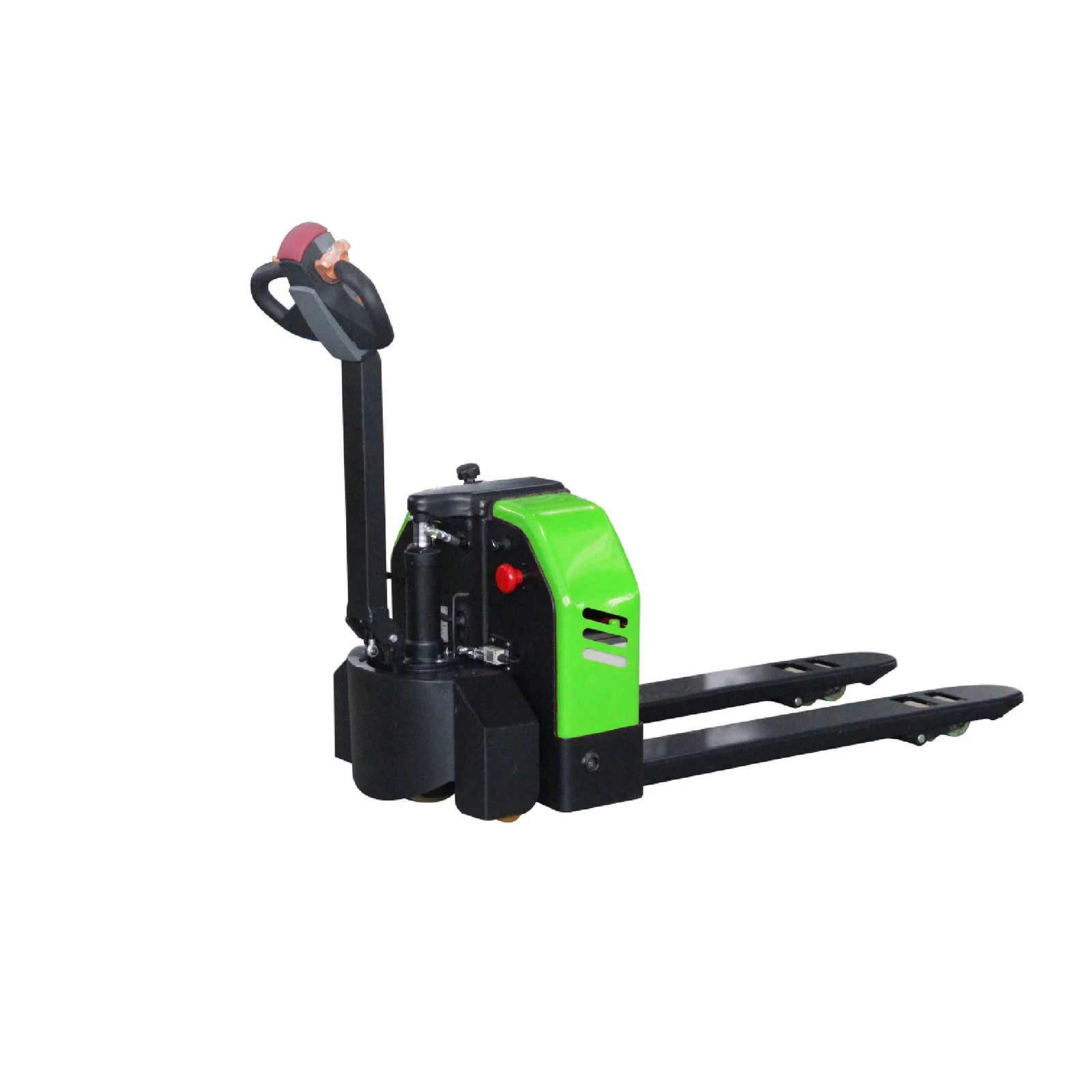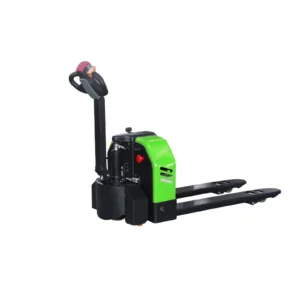In the bustling world of warehouses, logistics, and material handling, efficiency is key. Among the tools and equipment utilized in these environments, electric pallet jacks stand out as indispensable assets. Often, there’s a misconception about whether electric pallet jacks are synonymous with forklifts. Let’s delve into the nuances, functionalities, and operational aspects of electric pallet jacks to clarify this distinction.
What is an Electric Pallet Jack?
An electric pallet jack, also known as a powered pallet truck or electric pallet truck, is a versatile piece of equipment used for moving and lifting palletized loads within a warehouse or distribution center. Unlike traditional pallet jacks, which are manually operated, electric pallet jacks are powered by electricity, making them more efficient and suitable for heavier loads.
Electric pallet jacks consist of a forked platform attached to a wheeled base, with an electric motor providing the necessary power for movement and lifting. These machines are designed to navigate narrow aisles and tight spaces with ease, making them ideal for confined warehouse environments.
How Does an Electric Pallet Jack Work?
Operating an electric pallet jack is relatively straightforward, but it requires proper training and adherence to safety protocols. Here’s a step-by-step guide to operating an electric pallet jack:
Pre-Operation Inspection
Before using the electric pallet jack, conduct a thorough inspection to ensure it’s in proper working condition. Check for any visible damage, leaks, or malfunctions.
Power On
Switch on the power button of the electric pallet jack, usually located on the control panel or handle.
Adjust Fork Width
If necessary, adjust the width of the forks to match the width of the pallet you’ll be handling. Most electric pallet jacks feature adjustable forks to accommodate different pallet sizes.
Approach the Load
Position the electric pallet jack in front of the pallet, ensuring the forks are aligned with the openings between the pallet’s bottom deck boards.
Lower the Forks
Using the controls on the handle, lower the forks until they are slightly below the pallet. This allows for easy insertion of the forks beneath the pallet.
Insert Forks
Slowly drive the electric pallet jack forward, guiding the forks into the openings between the pallet’s bottom deck boards. Make sure the forks are fully inserted and positioned securely under the pallet.
Lift the Load
Once the forks are securely under the pallet, use the controls to raise the forks, lifting the load off the ground. Exercise caution to ensure the load is balanced and stable.
Transport the Load
With the load lifted, maneuver the electric pallet jack to the desired location within the warehouse. Use the control handles to steer the machine and navigate around obstacles or tight corners.
Lower the Load
Once you’ve reached the destination, carefully lower the forks to the ground, gently setting the load in place. Ensure the load is fully supported before releasing it from the forks.
Power Off
After completing the operation, switch off the power to the electric pallet jack and return it to its designated storage area.
Are Electric Pallet Jacks Considered Forklifts?
The question of whether electric pallet jacks are considered forklifts often arises due to their similar functions in material handling. However, there are distinct differences between the two.
Forklifts
Forklifts are versatile industrial trucks equipped with a mast and forks used for lifting and transporting heavy loads. They come in various configurations, including sit-down, stand-up, and reach trucks, and are capable of lifting loads to significant heights.
Forklifts require specialized training and certification to operate due to their complexity and potential hazards. They are commonly used for tasks such as loading and unloading trucks, stacking pallets in racks, and moving bulky materials in manufacturing facilities.
Electric Pallet Jacks
Electric pallet jacks, on the other hand, are designed specifically for horizontal material movement and short-distance transport of palletized loads. While they can lift loads off the ground, they lack the vertical lifting capabilities of forklifts.
Electric pallet jacks are easier to maneuver in tight spaces and are well-suited for tasks such as order picking, replenishing stock, and transferring loads from one location to another within a warehouse or distribution center.
Differences Between Electric Pallet Jacks and Forklifts
To further clarify the distinction between electric pallet jacks and forklifts, let’s explore their differences in more detail:
Lifting Capacity
- Forklifts typically have higher lifting capacities compared to electric pallet jacks. Forklifts are capable of lifting loads to considerable heights, often several meters above the ground, making them suitable for stacking pallets in high-reaching warehouse racks.
- Electric pallet jacks, while capable of lifting loads off the ground, are designed primarily for horizontal movement and have lower lifting capacities compared to forklifts. They are ideal for transporting pallets over short distances on flat surfaces within a facility.
Vertical Reach
- Forklifts are equipped with masts that allow for vertical lifting of loads, enabling them to access elevated storage locations and maneuver in multi-level warehouse environments.
- Electric pallet jacks lack the vertical reach of forklifts and are unable to lift loads to significant heights. They are best suited for ground-level material handling tasks, such as loading and unloading trucks, moving pallets in storage aisles, and transferring goods within a facility.
Maneuverability
- Electric pallet jacks are known for their agility and maneuverability, particularly in confined spaces and narrow aisles. Their compact design and tight turning radius make them well-suited for navigating congested warehouse environments.
- Forklifts, while versatile, may have limitations in maneuverability, especially in tight spaces. Certain types of forklifts, such as reach trucks, are designed for improved maneuverability in narrow aisles, but they may still require more space compared to electric pallet jacks.
Operator Training
- Operating a forklift requires specialized training and certification due to the complexity of the machinery and the potential risks associated with handling heavy loads at elevated heights.
- Electric pallet jacks are relatively easier to operate and require minimal training compared to forklifts. However, operators should still receive proper instruction on safe operating procedures, including load handling, maneuvering, and maintenance.
Best Practices for Operating Electric Pallet Jacks:
While electric pallet jacks are simpler to operate compared to forklifts, it’s essential to follow best practices to ensure safe and efficient operation:
Training and Certification
Ensure that operators receive comprehensive training and certification specific to electric pallet jack operation. Training should cover safety protocols, equipment operation, load handling techniques, and emergency procedures.
Pre-Operation Inspection
Conduct a thorough inspection of the electric pallet jack before each use to check for any signs of damage, wear, or malfunction. Inspect the wheels, forks, hydraulic system, and electrical components to ensure they are in proper working condition.
Load Handling Techniques
- Properly position the forks beneath the pallet, ensuring they are inserted securely and evenly to prevent load shifting during transport.
- Avoid overloading the electric pallet jack beyond its rated capacity, as this can compromise stability and safety.
Safe Maneuvering
Exercise caution when maneuvering the electric pallet jack, especially in congested areas or around obstacles. Maintain a clear line of sight and be mindful of pedestrians, other equipment, and potential hazards in the vicinity.
Battery Maintenance:
- Follow manufacturer guidelines for battery maintenance, including regular charging, watering (if applicable), and inspection for signs of corrosion or damage.
- Avoid over-discharging the battery, as this can shorten its lifespan and impact performance.
Emergency Procedures:
- Familiarize operators with emergency procedures, including how to safely stop the electric pallet jack in case of an emergency, how to lower the load in the event of a power failure, and how to respond to equipment malfunctions or accidents.
By adhering to these best practices and maintaining a proactive approach to safety, operators can mitigate risks and ensure the efficient operation of electric pallet jacks in warehouse and distribution environments. Effective training, proper maintenance, and a focus on safety culture are essential elements in maximizing the productivity and longevity of electric pallet jack operations.
Electric Pallet Trucks are versatile machines offer a blend of power, maneuverability, and efficiency, making them indispensable assets in warehouses, distribution centers, and manufacturing facilities.
GET IT NOW
Functionality and Design
Electric pallet trucks feature a compact yet robust design, consisting of a forked platform mounted on a wheeled base. Unlike manual pallet trucks that require physical effort to operate, electric pallet trucks are powered by electricity, allowing operators to effortlessly maneuver heavy loads with ease. The electric motor provides the necessary propulsion and lifting capabilities, enabling smooth and efficient movement of palletized goods.
Advantages of Electric Pallet Trucks
- Efficiency: Electric pallet trucks significantly enhance operational efficiency by reducing manual labor and streamlining material handling processes. Operators can effortlessly transport palletized loads over short distances, minimizing downtime and maximizing productivity.
- Maneuverability: With their compact design and tight turning radius, electric pallet trucks excel in navigating narrow aisles, congested spaces, and confined environments within warehouses. This maneuverability enables operators to efficiently move goods to and from storage locations, loading docks, and production areas.
- Versatility: Electric pallet trucks are highly versatile and adaptable to a wide range of applications. They can handle various types of pallets, including standard, Euro, and custom-sized pallets, making them suitable for diverse industries and operational requirements.
- Safety: Electric pallet trucks are equipped with safety features designed to protect both operators and goods. Features such as anti-roll-back systems, emergency stop buttons, and ergonomic handle designs enhance operator safety and minimize the risk of accidents or injuries during operation.
Operating an Electric Pallet Truck
Operating an electric pallet truck is relatively straightforward, but it requires proper training and adherence to safety protocols. Here’s a step-by-step guide to operating an electric pallet truck:
Pre-Operation Inspection
Conduct a thorough inspection of the electric pallet truck to ensure it’s in proper working condition. Check for any visible damage, leaks, or malfunctions before use.
Power On
Switch on the power button of the electric pallet truck, usually located on the control panel or handle.
Adjust Fork Width
If necessary, adjust the width of the forks to match the size of the pallet you’ll be handling.
Approach the Load
Position the electric pallet truck in front of the pallet, ensuring the forks are aligned with the openings between the pallet’s bottom deck boards.
Lower the Forks
Using the controls on the handle, lower the forks until they are slightly below the pallet.
Insert Forks
Slowly drive the electric pallet truck forward, guiding the forks into the openings between the pallet’s bottom deck boards.
Lift the Load
Once the forks are securely under the pallet, use the controls to raise the forks, lifting the load off the ground.
Transport the Load
Maneuver the electric pallet truck to the desired location within the warehouse, ensuring a clear path and avoiding obstacles.
Lower the Load
Once you’ve reached the destination, carefully lower the forks to the ground, gently setting the load in place.
Power Off
After completing the operation, switch off the power to the electric pallet truck and return it to its designated storage area.
In the fast-paced world of warehouses and logistics, the efficiency of material handling operations is paramount. Electric pallet jacks and electric pallet trucks are two indispensable tools that contribute significantly to streamlining these operations. While electric pallet jacks are designed for horizontal movement and short-distance transport of palletized loads, electric pallet trucks offer enhanced maneuverability and efficiency in navigating narrow aisles and confined spaces within warehouse environments.
Understanding the functionalities, operational aspects, and differences between electric pallet jacks, electric pallet trucks, and forklifts is crucial for optimizing warehouse workflows and promoting safety. By adhering to best practices for operation, including proper training, pre-operation inspection, load handling techniques, and maintenance, businesses can maximize the productivity and longevity of these essential material handling equipment.
Get in touch with us now to find out more about our wide selection of material handling solutions and how they can help your business. Let’s work together to boost your efficiency.


